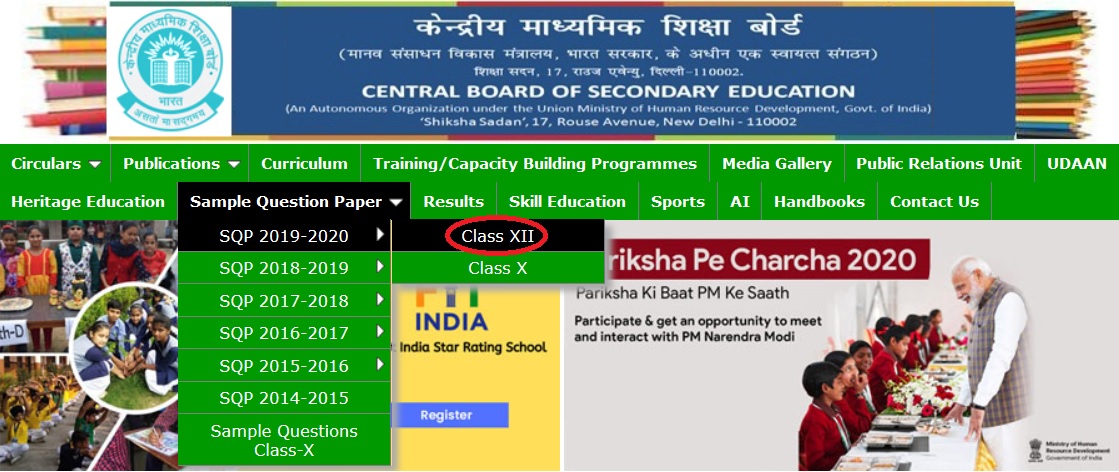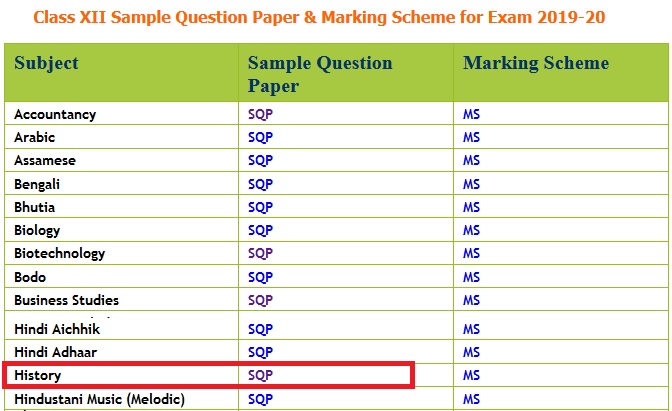CBSE Academic Class XII History Sample Question Paper 2019-20 : cbseacademic.nic.in
Name of the Board : CBSE Academic
Class : XII STD
Document Type : Sample Question Paper
Subject : History
Paper : Class XII Sample Question Paper 2019-20
Year : 2019-20
Website : http://cbseacademic.nic.in/SQP_CLASSXII_2019_20.html
CBSE XII History Sample Question Paper
Download Question Paper of Class XII History Sample Question Paper 2019-20 is now available in the official website of CBSE Academic.
Related : CBSE Academic Class 12 Economics Sample Question Paper 2019-20 : www.pdfquestion.in/34605.html

Part- A
1 Consider the following statements regarding the identification of Shiva, a figure represented on Harappan seals
1. It is shown in the form of Gajapati
2. It is shown seated in Yogic posture.
3. It is surrounded by animals.
4. It is shown with a female figure identifiable with Parvati.
Which of the above are correct reasons for identifying the figure with Shiva?
a. 1 and 4
b. 2 and 3
c. 2 and 4
d. 3 and 4
2 Name any two centres for making shell objects in the Harappan Civilisation.
3 Define a votive inscription.
4 Differentiate between polygyny and polyandry.
5 Choose the correct option :
Buddhism grew rapidly both during the lifetime of the Buddha and after his death as
A.Buddha and his disciples taught in Prakrit.
B.Importance was given to rituals in Buddhism.
C.People were dissatisfied with existing social practices.
D.Only men were allowed into the Sangha.
6 The special officers appointed to spread the message of Dhamma by Asoka were known as______________
7 From among the following which one depicts the correct meaning of the term Jins-i-kamil concerning crops in Mughal India?
A. Paddy crop
B. Perfect crop
C. Pulses
D. Crop grown in the arid zone
8 Choose the correct option :
The European traveller who has given a detailed description of the practice of Sati.
A. Jean Baptiste Tavernier
B. Manucci
C. Francois Bernier
D. Roberto Nobili
9 Identify which of the following aspects is NOT common to both Bhakti movement and Sufi movement?
A. Personal love for God
B. Worship of idols
C. Mysticism
D. Visit to holy shrines
10 Name the traveller for whom the term, globe-trotter, is used.
11 With which of the following responsibilities Mir Bakshi was the officer in Akbar’s reign?
A. Revenue Collection
B. Payment of salaries
C. Head of the military administration
D. Head of Nobility
12 Find out from the following pairs which one is correctly matched
A. Akbar Nama : Abdul Hamid Lahori
B. Badshah Nama : Zahiruddin Babur
C. Humayun Nama : Gulbadan Begum
D. Babur Nama: Abul FazlAllami
13 Mention one reason why Qandahar was a bone of contention between the Safavids and the Mughals.
14 Give the meaning of the term ‘Antyaja’.
15 Cite one reason for mapping of the cities by the colonial government.

Part-B
21 State any three elements that historians considered while analysing the Mahabharata.
22 ”Buildings or architectural remains are a source for reconstruction for temple architecture.” Justify the statement with reference to theVitthala temple of Vijayanagara Empire.
OR
”Krishnadeva Raya’s rule was characterised by expansion and consolidation”. Justify with suitable arguments.
23 Show how the power of the Jotedars within a village was more effective than that of the Zamindars.
24 Explain the grievances of the Indian sepoys against the British rule before the revolt of 1857 with examples.
Part- C
25 “Historians often try to understand the meaning of sculpture by comparing it with textual evidence.” Evaluate the statement in the context of Sanchi Stupa.
OR
”Amaravati was discovered before Sanchi yet it had lost its glory and was an insignificant little mound.” In the light of the above statement justify why Sanchi survived but Amaravati did not?
26 Describe the relations between the state and the Bhakti and Sufi traditions.
OR
Describe the teaching of Baba Guru Nanak and its relevance in today’s world.
27 Explain how the coming of Gandhiji broadened the base of the Indian National Movement.
OR
Explain how the partition of India was a culmination of communal politics that started developing in the opening decades of the 20th century.
Download Class XII History Question Paper 2019-20 :
https://www.pdfquestion.in/uploads/pdf2019/34610-His.pdf
Part- D
28 Evidence of an “invasion”
Deadman Lane is a narrow alley, varying from 3 to 6 feet in width….At the point where the lane turns westward, part of a skull and the bones of the thorax and upper arm of an adult were discovered, all in a very friable condition, at a depth of 4 ft 2 in.
The body lay on its back diagonally across the lane. Fifteen inches to the west were a few fragments of a tiny skull. It is to these remains that the lane owes its name. From John Marshall, Mohenjodaro and the Indus Civilisation,1931.
a. Why is the lane called the Deadman Lane?
b. State the conclusions that scholars and archaeologists draw from this information?
c. Give reasons to justify that the earlier interpretations can sometimes be reversed?